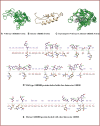A GHRHR founder mutation causes isolated growth hormone deficiency type IV in a consanguineous Pakistani family
- PMID: 36960394
- PMCID: PMC10029353
- DOI: 10.3389/fendo.2023.1066182
A GHRHR founder mutation causes isolated growth hormone deficiency type IV in a consanguineous Pakistani family
Abstract
Background: Isolated growth hormone deficiency (IGHD) is caused by a severe shortage or absence of growth hormone (GH), which results in aberrant growth and development. Patients with IGHD type IV (IGHD4) have a short stature, reduced serum GH levels, and delayed bone age.
Objectives: To identify the causative mutation of IGHD in a consanguineous family comprising four affected patients with IGHD4 (MIM#618157) and explore its functional impact in silico.
Methods: Clinical and radiological studies were performed to determine the phenotypic spectrum and hormonal profile of the disease, while whole-exome sequencing (WES) and Sanger sequencing were performed to identify the disease-causing mutation. In-silico studies involved protein structural modeling and docking, and molecular dynamic simulation analyses using computational tools. Finally, data from the Qatar Genome Program (QGP) were screened for the presence of the founder variant in the Qatari population.
Results: All affected individuals presented with a short stature without gross skeletal anomalies and significantly reduced serum GH levels. Genetic mapping revealed a homozygous nonsense mutation [NM_000823:c.G214T:p.(Glu72*)] in the third exon of the growth-hormone-releasing hormone receptor gene GHRHR (MIM#139191) that was segregated in all patients. The substituted amber codon (UAG) seems to truncate the protein by deleting the C-terminus GPCR domain, thus markedly disturbing the GHRHR receptor and its interaction with the growth hormone-releasing hormone.
Conclusion: These data support that a p.Glu72* founder mutation in GHRHR perturbs growth hormone signaling and causes IGHD type IV. In-silico and biochemical analyses support the pathogenic effect of this nonsense mutation, while our comprehensive phenotype and hormonal profiling has established the genotype-phenotype correlation. Based on the current study, early detection of GHRHR may help in better therapeutic intervention.
Keywords: GHRHR; Pakistani family; docking and simulation; isolated growth hormone deficiency (IGHD4); modeling; whole-exome sequencing.
Copyright © 2023 Ahmad, Ali, Abbasi, Abbas, Ahmed, Abbas, Nawaz, Ziab, Ahmed, Fakhro, Khan and Akil.
Conflict of interest statement
The authors declare that the research was conducted in the absence of any commercial or financial relationships that could be construed as a potential conflict of interest.
Figures




References
-
- Vimpani GV. Short stature in Scottish schoolchildren: A community study with special emphasis on the prevalence of severe growth hormone deficiency. In: Annexe thesis digitisation project 2016 block 4 (1977). Available at: https://era.ed.ac.uk/handle/1842/17702?show=full.
-
- Cogan JD, Phillips JA, 3rd. Gh1 gene deletions and ighd type 1a. Pediatr Endocrinol Rev (2006) 3:480–8. - PubMed
Publication types
MeSH terms
Substances
LinkOut - more resources
Full Text Sources

